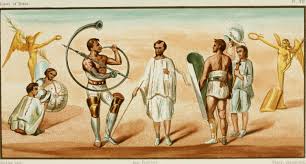Roman Gladiators Weapons: A gladiator (swordsman – a word derived from Roman gladius(sword) ) was an armed combatant who entertained audiences in the Roman Republic and Roman Empire in violent confrontations with other gladiators, wild animals, and condemned criminals.
Ancient Roman Gladiators Weapons
In ancient Rome, gladiators fought, often to the death, to entertain crowds of spectators. Gladiators were trained in Ludi to fight or gladiator fight well in circuses (or the Colosseum) where the ground surface was covered with blood-absorbing sand.

Gladiatorial contests, like chariot races, were originally were held in large open spaces with temporary seating; there is evidence that some Munera was held in the Roman Forum, for example. As the games became more frequent and popular, there was a need for a larger and more permanent structure.
Gladiators came from a surprisingly diverse group. Gladiators were usually men, but they could also be women. They were usually slaves, but their number included emperors.
Weapons of the Gladiator
Slaves chosen as gladiators tended to be 1st-generation slaves bought or acquired in war or condemned slaves.
Roman Gladiator Armor
Gladiators were divided into categories based on how they fought, their armor, and Roman Gladiators Weapons. There were horseback gladiators, gladiators in chariots, gladiators who fought in pairs, and gladiators named for their origin, like the Thracian gladiators.

Gladiators were trained at special schools originally owned by private citizens but later taken over by the imperial state to prevent the build-up of a private army. Gladiators trained like true athletes, much like professional athletes do today. They received medical attention and three meals a day.
Gladiators Weapons Facts
Gladiators were paid each time they fought. If a gladiator survived three to five years of combat they were freed. Gladiators fought in arenas, the most famous of which was the Colosseum built by the Flavians.
When one of the opponents in a contest was wounded, the crowd would typically shout “Habet, Hoc Habet,” he has had it. An opponent who felt he was defeated would raise his left hand with one finger extended as a request for mercy.

The manager of a gladiatorial troupe was called a List; he provided lengthy and demanding training in schools (Ludi) specially designed for this purpose and usually located near the great amphitheaters.
Pompeii, for example, had both a small training are surrounded by gladiatorial barracks and a large one right next to the amphitheater. During the imperial period, all the gladiatorial schools in Rome were under the direct control of the emperor.
Here are the types of weapons gladiators used:
- fascina: harpoon
- galea: visored helmet
- Galerius: metal shoulder piece
- gladius: sword
- hasta: lance
- Iaculum: net
- Manicae: leather elbow or wristbands
- ocrea: metal or boiled leather greave
- parma: round shield
- scutum: large oblong shield
- sica: curved scimitar
- subiculum: loincloth




